This site uses cookies as defined in our Cookie Policy, by continuing to use this site you agree to their use.
Continue
This magical Southeast Asia river cruise along the Mekong River will take you through Cambodia and Vietnam, showing you the culture and local traditions of each country and the must-see sites along the way.
Your adventure begins in Siem Reap, Cambodia, with the magnificent Temples of Angkor. Constructed between the 9th and 13th centuries, these ancient ruins are a display of architectural complexity and grandeur unlike anything else in the world. Stand in awe at the most famous of these temples, Angkor Wat, dedicated to the Hindu god, Vishnu; and the Bayon temple, which features some ... 200 mysterious faces carved in its many towers. Enjoy an inspiring Apsara dance performance and other treasures of the city before embarking on your river cruise. In Kampong Tralach, an ox-cart ride will show you the Cambodian countryside and you’ll meet a local farmer and learn about his daily life. The temple of Wat Hanchey, perched on a hilltop, will provide the most stunning views, and then take part in a traditional water blessing with local monks.
Continue your journey into Vietnam and stroll through a local market—a unique opportunity to see locals buying and selling fresh produce. Via sampan, visit the home of a local family for a cotton-weaving demonstration and a local workshop which makes rice wine and traditional candies. In bustling Ho Chi Minh City, try your hand in the kitchen with a Vietnamese cooking class and go on an excursion to the Cu Chi Tunnels—the extraordinary network of tunnels used by the Viet Cong during the war.
Fly to Hanoi and explore the famous sites, such as the Old Quarter, where peddlers have traded goods for centuries on its 36 ancient streets. Next, a remarkable 2-night cruise along Ha Long Bay will show you its beautiful Limestone Islands. You’ll visit the Cua Van Floating Village, spectacular caves, and even go for a swim at Ti Top Island. The perfect ending to an unforgettable Southeast Asia river cruise vacation!
| Arrive | Depart | ||||||
| 2nd02 | DecDec | 202424 | 3 nights accommodation before your cruise, staying in Siem Reap | ||||
| 5th05 | DecDec | 202424 | Phnom Penh, Cambodia, embark on the Avalon Saigon | ||||
| Phnom Penh, Cambodia’s busy capital, sits at the junction of the Mekong and Tonlé Sap rivers. It was a hub for both the Khmer Empire and French colonialists. On its walkable riverfront, lined with parks, restaurants and bars, are the ornate Royal Palace, Silver Pagoda and the National Museum, displaying artifacts from around the country. At the city’s heart is the massive, art deco Central Market. PHNOM PENH (EMBARKATION) Your Suite Ship® Awaits! Fly to Phnom Penh and transfer to the port where your ship’s crew will be waiting to welcome you onboard. Get acquainted with the ship and relax before your welcome reception this evening. AFTERNOON/EVENING CRUISE TO WAT HANCHEY
PHNOM-PENH-WELCOME.jpg | |||||||
| 6th06 | DecDec | 202424 | Angkor Ban, Cambodia | ||||
WAT HANCHEY–ANGKOR BAN Water Blessings and Back-to-School Adventures DISCOVERY Visit Wat Hanchey, a hilltop temple dating back to the 8th century. Climb or be driven to the top where you will enjoy stunning views of the surrounding area and partake in a traditional water blessing given by local monks. DISCOVERY After lunch, enjoy a Walking Tour through the rural village of Angkor Ban. Here, you will visit a traditional Khmer house and interact with children at a local school. EVENING/OVERNIGHT CRUISE TO KAMPONG TRALACH WAT-HANCHEY.jpg | |||||||
| 7th07 | DecDec | 202424 | Kampong Tralach, Cambodia | ||||
KAMPONG TRALACH–KONPONG LOUANG Calm in the Cambodian Countryside DISCOVERY Your Guided Sightseeing starts in Kampong Tralach with an ox-cart Ride through the beautiful Cambodian countryside. Along the way, stop to meet a local farmer and learn about his daily life. At the silversmith village in Konpong Louang, see talented craftsmen use age-old techniques to turn pure silver into works of art. Sail to the capital city of Phnom Penh this afternoon. PHNOM PENH A Dark History or Market Dynamics CLASSIC After lunch, a Visit to the Tuol Sleng Genocide Museum and one of the Killing Fields offers a glimpse into the atrocities inflicted on the Cambodian people by the Khmer Rouge regime, OR: DISCOVERY Visit the lively Central Market with its unique Art Deco design by tuk-tuk. This evening, spend some free time exploring the city on your own. Perhaps follow the riverfront promenade to the historic Foreign Correspondents Club (FCC). KAMPONG-TRALACH-OX-CART.jpg | |||||||
| 8th08 | DecDec | 202424 | Phnom Penh, Cambodia | ||||
| Phnom Penh, Cambodia’s busy capital, sits at the junction of the Mekong and Tonlé Sap rivers. It was a hub for both the Khmer Empire and French colonialists. On its walkable riverfront, lined with parks, restaurants and bars, are the ornate Royal Palace, Silver Pagoda and the National Museum, displaying artifacts from around the country. At the city’s heart is the massive, art deco Central Market. PHNOM PENH The Royal Treatment CLASSIC Join a Guided Tour of the city by private cyclo with visits to the Royal Palace with the spectacular Silver Pagoda, and the National Museum featuring an outstanding display of Khmer artifacts. The remainder of the day is yours to enjoy at your leisure. Just before dinner, children from a local orphanage will perform a show, featuring local song and dance. EVENING/OVERNIGHT CRUISE TO VIETNAM/CAMBODIA BORDER
PHNOM-PENH-ROYAL-PALACE.jpg | |||||||
| 9th09 | DecDec | 202424 | Châu Đốc, Vietnam | ||||
BORDER CROSSING–CHAU DOC, VIETNAM Good Morning, Vietnam! DISCOVERY Take a Village Walk through the Chau Doc market and absorb the atmosphere as locals are busy buying and selling fish, meat, and produce. After lunch, embark on a Guided Excursion down the backwaters of the Mekong. Along the way, see traditional floating homes, speedboat merchants, religious sites, a market selling dried goods, and more. EVENING CRUISE TO LONG KHANH A CHAU-DOC-MARKET.jpg | |||||||
| 10th10 | DecDec | 202424 | Long Khánh, Vietnam | ||||
LONG KHANH A–CU LAO GIENG Cotton Weaving, Conical Hats, and Handcrafted Sampans DISCOVERY This morning, a sampan brings you to the village of Long Khanh A, for a Cotton-Weaving Demonstration of this well-preserved tradition. DISCOVERY This afternoon, enjoy scenes of daily life on Cu Lao Gieng Island via sampan and local motor cart. Your Guided Excursion starts with a stop at one of Vietnam’s oldest Catholic churches. Then, visit the home of a local family that makes Vietnamese conical hats, or “Non la,” from materials available to them such as palm leaves and bamboo. These iconic hats are primarily used as protection from the sun and rain, but you may also see them used as a basket to carry home goods from the market. Lastly, visit a local workshop where a skilled family hand-crafts sampan boats. EVENING CRUISE TO VINH LONG CU-LAO-GIENG-HAT-MAKING.jpg | |||||||
| 11th11 | DecDec | 202424 | Vinh Long, Vietnam | ||||
VINH LONG Sweets and Rice Treats DISCOVERY Board a sampan this morning to Visit a Local Workshop in Vinh Long where you will see how rice paper, rice wine, and traditional candies are made. This afternoon, enjoy time on board the ship as we sail to exciting Ho Chi Minh City. AFTERNOON CRUISE TO HO CHI MINH CITY VINH-LONG-BRICK-KILN.jpg | |||||||
| 12th12 | DecDec | 202424 | Ho Chi Minh City, Vietnam | ||||
| Romantically referred to by the French as the Pearl of the Orient, Ho Chi Minh City today is a super-charged city of sensory overload. Motorbikes zoom day and night along the wide boulevards, through the narrow back alleys and past vendors pushing handcarts hawking goods of all descriptions. Still called Saigon by most residents, this is Vietnam's largest city and the engine driving the country's current economic resurgence, but despite its frenetic pace, it's a friendlier place than Hanoi and locals will tell you the food—simple, tasty, and incorporating many fresh herbs—is infinitely better than in the capital.This is a city full of surprises. The madness of the city's traffic—witness the oddball things that are transported on the back of motorcycles—is countered by tranquil pagodas, peaceful parks, quirky coffee shops, and whole neighborhoods hidden down tiny alleyways, although some of these quiet spots can be difficult to track down. Life in Ho Chi Minh City is lived in public: on the back of motorcycles, on the sidewalks, and in the parks. Even when its residents are at home, they're still on display. With many living rooms opening onto the street, grandmothers napping, babies being rocked, and food being prepared, are all in full view of passersby.Icons of the past endure in the midst of the city’s headlong rush into capitalism. The Hotel Continental, immortalized in Graham Greene's The Quiet American, continues to stand on the corner of old Indochina's most famous thoroughfare, the rue Catinat, known to American G.I.s during the Vietnam War as Tu Do (Freedom) Street and renamed Dong Khoi (Uprising) Street by the Communists. The city still has its ornate opera house and its old French city hall, the Hôtel de Ville. The broad colonial boulevards leading to the Saigon River and the gracious stucco villas are other remnants of the French colonial presence. Grisly reminders of the more recent past can be seen at the city's war-related museums. Residents, however, prefer to look forward rather than back and are often perplexed by tourists' fascination with a war that ended 40 years ago.The Chinese influence on the country is still very much in evidence in the Cholon district, the city's Chinatown, but the modern office towers and international hotels that mark the skyline symbolize Vietnam's fixation on the future. HO CHI MINH CITY (DISEMBARKATION) Motorbikes, Monuments, and Mouthwatering Cuisine CLASSIC Take a Walking Tour of Ho Chi Minh City’s historic landmarks, including a stop at the Rex Hotel for a refreshing drink at the rooftop bar where the U.S. Military held the infamous “Five O’clock Follies” during the war. Then, visit the War Remnants Museum and bustling Ben Thanh Market. DISCOVERY For lunch, participate in a hands-on Vietnamese Cooking Class. Learn to prepare several local dishes and how to recreate them at home. Last, but not least, sample your delicious creations! Enjoy time at your leisure this afternoon and evening for independent exploration. Maybe stop for a drink at the famous rooftop bar at the Caravelle Hotel. HO-CHI-MINH-CITY-FOOD.jpg | |||||||
| 13th13 | DecDec | 202424 | Ho Chi Minh City, Vietnam | ||||
| Romantically referred to by the French as the Pearl of the Orient, Ho Chi Minh City today is a super-charged city of sensory overload. Motorbikes zoom day and night along the wide boulevards, through the narrow back alleys and past vendors pushing handcarts hawking goods of all descriptions. Still called Saigon by most residents, this is Vietnam's largest city and the engine driving the country's current economic resurgence, but despite its frenetic pace, it's a friendlier place than Hanoi and locals will tell you the food—simple, tasty, and incorporating many fresh herbs—is infinitely better than in the capital.This is a city full of surprises. The madness of the city's traffic—witness the oddball things that are transported on the back of motorcycles—is countered by tranquil pagodas, peaceful parks, quirky coffee shops, and whole neighborhoods hidden down tiny alleyways, although some of these quiet spots can be difficult to track down. Life in Ho Chi Minh City is lived in public: on the back of motorcycles, on the sidewalks, and in the parks. Even when its residents are at home, they're still on display. With many living rooms opening onto the street, grandmothers napping, babies being rocked, and food being prepared, are all in full view of passersby.Icons of the past endure in the midst of the city’s headlong rush into capitalism. The Hotel Continental, immortalized in Graham Greene's The Quiet American, continues to stand on the corner of old Indochina's most famous thoroughfare, the rue Catinat, known to American G.I.s during the Vietnam War as Tu Do (Freedom) Street and renamed Dong Khoi (Uprising) Street by the Communists. The city still has its ornate opera house and its old French city hall, the Hôtel de Ville. The broad colonial boulevards leading to the Saigon River and the gracious stucco villas are other remnants of the French colonial presence. Grisly reminders of the more recent past can be seen at the city's war-related museums. Residents, however, prefer to look forward rather than back and are often perplexed by tourists' fascination with a war that ended 40 years ago.The Chinese influence on the country is still very much in evidence in the Cholon district, the city's Chinatown, but the modern office towers and international hotels that mark the skyline symbolize Vietnam's fixation on the future. HO CHI MINH CITY. EXCURSION TO CU CHI TUNNELS Secret Passageways and Underground Hideouts CLASSIC Drive out of the city for a Guided Visit to the Cu Chi Tunnels—an extraordinary network of tunnels more than 120 miles in length—used as a hideout and secret village by the Viet Cong. Explore the city further during free time this afternoon. This evening, join your traveling companions for a special dinner in a local restaurant. HO-CHI-MINH-CITY-CU-CHI-TUNNELS.jpg | |||||||
| 14th14 | DecDec | 202424 | Ho Chi Minh City, Vietnam | ||||
| Romantically referred to by the French as the Pearl of the Orient, Ho Chi Minh City today is a super-charged city of sensory overload. Motorbikes zoom day and night along the wide boulevards, through the narrow back alleys and past vendors pushing handcarts hawking goods of all descriptions. Still called Saigon by most residents, this is Vietnam's largest city and the engine driving the country's current economic resurgence, but despite its frenetic pace, it's a friendlier place than Hanoi and locals will tell you the food—simple, tasty, and incorporating many fresh herbs—is infinitely better than in the capital.This is a city full of surprises. The madness of the city's traffic—witness the oddball things that are transported on the back of motorcycles—is countered by tranquil pagodas, peaceful parks, quirky coffee shops, and whole neighborhoods hidden down tiny alleyways, although some of these quiet spots can be difficult to track down. Life in Ho Chi Minh City is lived in public: on the back of motorcycles, on the sidewalks, and in the parks. Even when its residents are at home, they're still on display. With many living rooms opening onto the street, grandmothers napping, babies being rocked, and food being prepared, are all in full view of passersby.Icons of the past endure in the midst of the city’s headlong rush into capitalism. The Hotel Continental, immortalized in Graham Greene's The Quiet American, continues to stand on the corner of old Indochina's most famous thoroughfare, the rue Catinat, known to American G.I.s during the Vietnam War as Tu Do (Freedom) Street and renamed Dong Khoi (Uprising) Street by the Communists. The city still has its ornate opera house and its old French city hall, the Hôtel de Ville. The broad colonial boulevards leading to the Saigon River and the gracious stucco villas are other remnants of the French colonial presence. Grisly reminders of the more recent past can be seen at the city's war-related museums. Residents, however, prefer to look forward rather than back and are often perplexed by tourists' fascination with a war that ended 40 years ago.The Chinese influence on the country is still very much in evidence in the Cholon district, the city's Chinatown, but the modern office towers and international hotels that mark the skyline symbolize Vietnam's fixation on the future. HO CHI MINH CITY–HANOI Hanoi Bound Today, transfer to the airport and fly to Hanoi. Upon arrival, transfer to your hotel for the night. HANOI.jpg | |||||||
| 15th15 | DecDec | 202424 | Hanoi, Vietnam | ||||
HANOI Historic Hanoi and Water Puppets CLASSIC First, join a Guided Visit of the mausoleum and the humble cottage from which “Uncle Ho” ruled Vietnam until his death in 1969. Next, see iconic sites, including One Pillar Pagoda, the Presidential Palace, and the infamous “Hanoi Hilton.” Lastly, visit the 900-year-old Temple of Literature, Hanoi’s first university. Enjoy lunch at Koto, a non-profit restaurant and hospitality program that teaches local children restaurant skills for stable employment opportunities. CLASSIC After lunch, enjoy an Electric Cart Ride through the fascinating Old Quarter—with its 36 ancient streets where merchants trade as they have for centuries. DISCOVERY An early dinner this evening is followed by a fascinating Live Performance of Hanoi’s renowned water puppets, a traditional 11th-century artform. HANOI-ONE-PILLAR-PAGODA.jpg | |||||||
| 16th16 | DecDec | 202424 | Ha Long Bay, Vietnam | ||||
| A visit to the north is not complete without a trip to Halong Bay, where placid waters give way to more than 3,000 limestone karsts and wind-sculpted limestone formations that jut from foggy lagoons. Dotting the bay are tiny islands bordered by white sandy coves and hidden caves, adding to the majestic landscape of this UNESCO World Heritage Site. Adding to this naturalist’s dream is the biodiversity of islets, grottos, and Cat Ba Island National Park. The bay, however, shows tourism’s impact: the clearing of mangrove forests to make way for jetties and piers, marine life threatened by game fishing, and garbage from passenger boats and fishing villages washed up on the shores.Beyond its geological uniqueness are activities like hiking, kayaking, rock climbing, or exploring one of the many floating villages where fishermen bring in their daily catch. The downside to all this allure is the large number of unlicensed boats it draws to the bay each day.Boat trips out onto the bay are the main tourism stock in trade farther north, but a more multifaceted side of the area can be experienced at Cat Ba Island. The largest island in Halong Bay, Cat Ba is very much its own entity. Its national park offers incredible biodiversity, with more than a thousand species of plants having been recorded here. Animal life is slightly thinner on the ground, but alert visitors may spy inhabitants such as the endangered golden-headed langur, wild boar, deer, civets, and several species of squirrel. Trekking through the wilderness is a highlight with a number of fascinating trails to follow.Cat Ba Island has also become a firm favorite with the adventure sports set. Indeed, along with Railay Beach in Thailand, it is recognized as one of the top spots in the region for rock climbing. Other outdoor pursuits include sailing and kayaking around the karsts. Although Halong Bay has arguably been tainted by over-exposure, Bai Tu Long Bay farther east toward China, retains all the majesty of Vietnam’s premier bucket-list natural attraction but sees a fraction of the traffic of its immediate neighbor to the west. Here, visitors will find islands of substantial size with deserted beaches and untamed jungle. Halong Bay's 3,000 islands of dolomite and limestone cover a 1,500-square-km (580-square-mile) area, extending across the Gulf of Tonkin nearly to the Chinese border. According to legend, this breathtaking land- and seascape was formed by a giant dragon that came barreling out of the mountains toward the ocean—hence the name (Halong translates into "descent of the dragon"). Geologists are more likely to attribute the formations to sedimentary limestone that formed here between 300 and 500 million years ago, in the Paleozoic Era. Over millions of years water receded and exposed the limestone to wind, rain, and tidal erosion.Today the limestone formations are exposed to hordes of tourists—but don't let that discourage you. Hundreds of fishing trawlers and tour boats share space on these crystal waters, yet there seems to be room for everyone. Most people use the main population center, Halong City, as a base from which to venture into the bay. Although it's now officially one municipality, Halong City was, until 1996, two separate towns: Bai Chay is now Halong City West, where Halong Road winds its way around the coast and past the lifeless central beach; Hon Gai is the grimier Halong City East, where a coal transportation depot dominates the center of town and covers nearby roads and buildings with a sooty film. Locals still refer to the towns by their old names, but they are now inexorably lassoed together by a bridge. Boat trips through Halong Bay are the main attraction. Little of the majesty of this region can be found in the city, so head out onto the water and start exploring. Countless 10- and 30-foot fishing boats have been converted into Halong Bay's formidable tourist-boat fleet. Hotels or travel agencies in Halong City or Hanoi can arrange boat trips for you (often they are part of organized tours from Hanoi). It is still possible to go down to the wharf and bargain yourself onto a boat for the day, but you are likely to be charged (sometimes significantly) more than you would pay for a prebooked tour, so this is not advised. Self-sufficient travelers have fallen victim to the old bait-and-switch: they've arranged a next-day boat tour with local fishermen, only to be told in no uncertain terms the following morning that they could not board their chosen boat, but they could take a different one for quite a bit more money. You may have no choice in the end. Usually travel agencies, however, have their tried-and-true favorites. HANOI–HA LONG BAY Island Shapes and a Floating Village Travel from Hanoi through the fertile countryside to Ha Long Bay, a UNESCO World Heritage Site. The bay is dotted with more than 3,000 limestone islands carved into fanciful shapes. Board the luxurious Paradise Elegance for a 2-Night Cruise on the bay. DISCOVERY Visit the Cua Van Floating Village, home to more than 700 people, by bamboo raft, OR: ACTIVE Take a Kayak Ride to visit Cua Van Village. Enjoy scenic sailing for the remainder of the day before anchoring for the night. HANOI-ONE-PILLAR-PAGODA.jpg | |||||||
| 17th17 | DecDec | 202424 | Ha Long Bay, Vietnam | ||||
| A visit to the north is not complete without a trip to Halong Bay, where placid waters give way to more than 3,000 limestone karsts and wind-sculpted limestone formations that jut from foggy lagoons. Dotting the bay are tiny islands bordered by white sandy coves and hidden caves, adding to the majestic landscape of this UNESCO World Heritage Site. Adding to this naturalist’s dream is the biodiversity of islets, grottos, and Cat Ba Island National Park. The bay, however, shows tourism’s impact: the clearing of mangrove forests to make way for jetties and piers, marine life threatened by game fishing, and garbage from passenger boats and fishing villages washed up on the shores.Beyond its geological uniqueness are activities like hiking, kayaking, rock climbing, or exploring one of the many floating villages where fishermen bring in their daily catch. The downside to all this allure is the large number of unlicensed boats it draws to the bay each day.Boat trips out onto the bay are the main tourism stock in trade farther north, but a more multifaceted side of the area can be experienced at Cat Ba Island. The largest island in Halong Bay, Cat Ba is very much its own entity. Its national park offers incredible biodiversity, with more than a thousand species of plants having been recorded here. Animal life is slightly thinner on the ground, but alert visitors may spy inhabitants such as the endangered golden-headed langur, wild boar, deer, civets, and several species of squirrel. Trekking through the wilderness is a highlight with a number of fascinating trails to follow.Cat Ba Island has also become a firm favorite with the adventure sports set. Indeed, along with Railay Beach in Thailand, it is recognized as one of the top spots in the region for rock climbing. Other outdoor pursuits include sailing and kayaking around the karsts. Although Halong Bay has arguably been tainted by over-exposure, Bai Tu Long Bay farther east toward China, retains all the majesty of Vietnam’s premier bucket-list natural attraction but sees a fraction of the traffic of its immediate neighbor to the west. Here, visitors will find islands of substantial size with deserted beaches and untamed jungle. Halong Bay's 3,000 islands of dolomite and limestone cover a 1,500-square-km (580-square-mile) area, extending across the Gulf of Tonkin nearly to the Chinese border. According to legend, this breathtaking land- and seascape was formed by a giant dragon that came barreling out of the mountains toward the ocean—hence the name (Halong translates into "descent of the dragon"). Geologists are more likely to attribute the formations to sedimentary limestone that formed here between 300 and 500 million years ago, in the Paleozoic Era. Over millions of years water receded and exposed the limestone to wind, rain, and tidal erosion.Today the limestone formations are exposed to hordes of tourists—but don't let that discourage you. Hundreds of fishing trawlers and tour boats share space on these crystal waters, yet there seems to be room for everyone. Most people use the main population center, Halong City, as a base from which to venture into the bay. Although it's now officially one municipality, Halong City was, until 1996, two separate towns: Bai Chay is now Halong City West, where Halong Road winds its way around the coast and past the lifeless central beach; Hon Gai is the grimier Halong City East, where a coal transportation depot dominates the center of town and covers nearby roads and buildings with a sooty film. Locals still refer to the towns by their old names, but they are now inexorably lassoed together by a bridge. Boat trips through Halong Bay are the main attraction. Little of the majesty of this region can be found in the city, so head out onto the water and start exploring. Countless 10- and 30-foot fishing boats have been converted into Halong Bay's formidable tourist-boat fleet. Hotels or travel agencies in Halong City or Hanoi can arrange boat trips for you (often they are part of organized tours from Hanoi). It is still possible to go down to the wharf and bargain yourself onto a boat for the day, but you are likely to be charged (sometimes significantly) more than you would pay for a prebooked tour, so this is not advised. Self-sufficient travelers have fallen victim to the old bait-and-switch: they've arranged a next-day boat tour with local fishermen, only to be told in no uncertain terms the following morning that they could not board their chosen boat, but they could take a different one for quite a bit more money. You may have no choice in the end. Usually travel agencies, however, have their tried-and-true favorites. HA LONG BAY Caves, Kayaks, and Scenic Climbs DISCOVERY Visit Ti top Island, for a Guided Excursion for a swim, or climb 400 steps to the top of the island for stunning views. You can also visit Luon Cave by boat, and explore Dark & Bright Cave by bamboo raft, OR: ACTIVE Explore Luon Cave and Dark & Bright Cave by Kayak Ride. After a day of exploring, consider a spa treatment or simply relax for happy hour prior to dinner! HA-LONG-BAY.jpg | |||||||
| 18th18 | DecDec | 202424 | Ha Long Bay, Vietnam, disembark the Avalon Saigon | ||||
| A visit to the north is not complete without a trip to Halong Bay, where placid waters give way to more than 3,000 limestone karsts and wind-sculpted limestone formations that jut from foggy lagoons. Dotting the bay are tiny islands bordered by white sandy coves and hidden caves, adding to the majestic landscape of this UNESCO World Heritage Site. Adding to this naturalist’s dream is the biodiversity of islets, grottos, and Cat Ba Island National Park. The bay, however, shows tourism’s impact: the clearing of mangrove forests to make way for jetties and piers, marine life threatened by game fishing, and garbage from passenger boats and fishing villages washed up on the shores.Beyond its geological uniqueness are activities like hiking, kayaking, rock climbing, or exploring one of the many floating villages where fishermen bring in their daily catch. The downside to all this allure is the large number of unlicensed boats it draws to the bay each day.Boat trips out onto the bay are the main tourism stock in trade farther north, but a more multifaceted side of the area can be experienced at Cat Ba Island. The largest island in Halong Bay, Cat Ba is very much its own entity. Its national park offers incredible biodiversity, with more than a thousand species of plants having been recorded here. Animal life is slightly thinner on the ground, but alert visitors may spy inhabitants such as the endangered golden-headed langur, wild boar, deer, civets, and several species of squirrel. Trekking through the wilderness is a highlight with a number of fascinating trails to follow.Cat Ba Island has also become a firm favorite with the adventure sports set. Indeed, along with Railay Beach in Thailand, it is recognized as one of the top spots in the region for rock climbing. Other outdoor pursuits include sailing and kayaking around the karsts. Although Halong Bay has arguably been tainted by over-exposure, Bai Tu Long Bay farther east toward China, retains all the majesty of Vietnam’s premier bucket-list natural attraction but sees a fraction of the traffic of its immediate neighbor to the west. Here, visitors will find islands of substantial size with deserted beaches and untamed jungle. Halong Bay's 3,000 islands of dolomite and limestone cover a 1,500-square-km (580-square-mile) area, extending across the Gulf of Tonkin nearly to the Chinese border. According to legend, this breathtaking land- and seascape was formed by a giant dragon that came barreling out of the mountains toward the ocean—hence the name (Halong translates into "descent of the dragon"). Geologists are more likely to attribute the formations to sedimentary limestone that formed here between 300 and 500 million years ago, in the Paleozoic Era. Over millions of years water receded and exposed the limestone to wind, rain, and tidal erosion.Today the limestone formations are exposed to hordes of tourists—but don't let that discourage you. Hundreds of fishing trawlers and tour boats share space on these crystal waters, yet there seems to be room for everyone. Most people use the main population center, Halong City, as a base from which to venture into the bay. Although it's now officially one municipality, Halong City was, until 1996, two separate towns: Bai Chay is now Halong City West, where Halong Road winds its way around the coast and past the lifeless central beach; Hon Gai is the grimier Halong City East, where a coal transportation depot dominates the center of town and covers nearby roads and buildings with a sooty film. Locals still refer to the towns by their old names, but they are now inexorably lassoed together by a bridge. Boat trips through Halong Bay are the main attraction. Little of the majesty of this region can be found in the city, so head out onto the water and start exploring. Countless 10- and 30-foot fishing boats have been converted into Halong Bay's formidable tourist-boat fleet. Hotels or travel agencies in Halong City or Hanoi can arrange boat trips for you (often they are part of organized tours from Hanoi). It is still possible to go down to the wharf and bargain yourself onto a boat for the day, but you are likely to be charged (sometimes significantly) more than you would pay for a prebooked tour, so this is not advised. Self-sufficient travelers have fallen victim to the old bait-and-switch: they've arranged a next-day boat tour with local fishermen, only to be told in no uncertain terms the following morning that they could not board their chosen boat, but they could take a different one for quite a bit more money. You may have no choice in the end. Usually travel agencies, however, have their tried-and-true favorites. HA LONG BAY–HANOI Surprising and Amazing Beauty This morning, relax onboard your ship, or visit Sung Sot Cave, considered one of the most beautiful in the area with its magnificent formations. Afterwards, return to Hanoi and check in to your hotel. The remainder of the day is yours to spend at your leisure. HA-LONG-BAY-SUNG-SOT-CAVE.jpg | |||||||
| 18th18 | DecDec | 202424 | 1 night accommodation following your cruise, staying in Hanoi | ||||
| 19th19 | DecDec | 202424 | Check out of accommodation | ||||
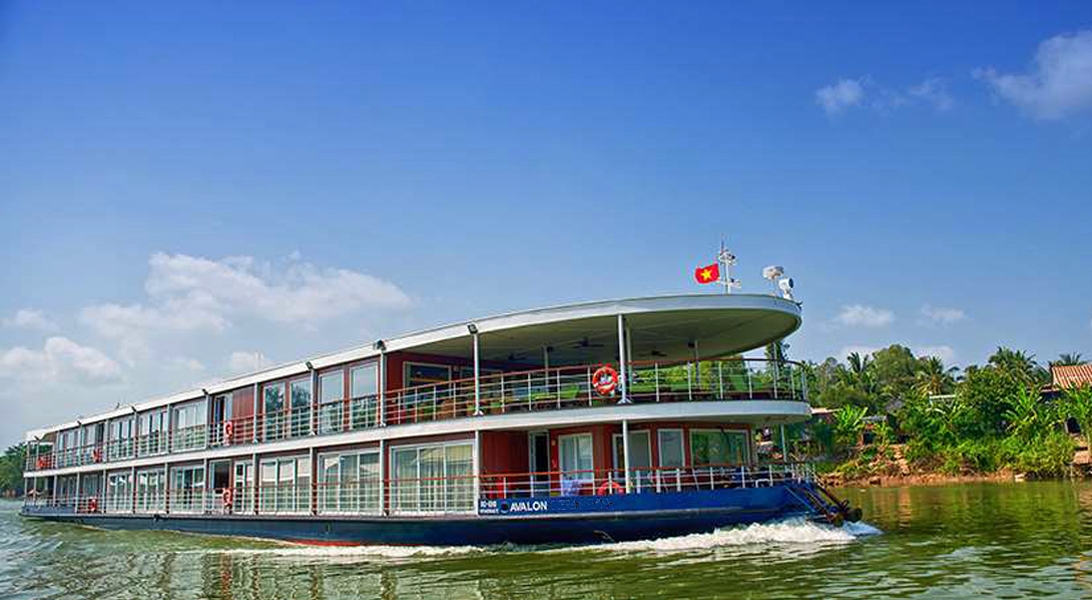


The images shown are for illustration purposes only and may not be an exact representation of what you find on the ship.
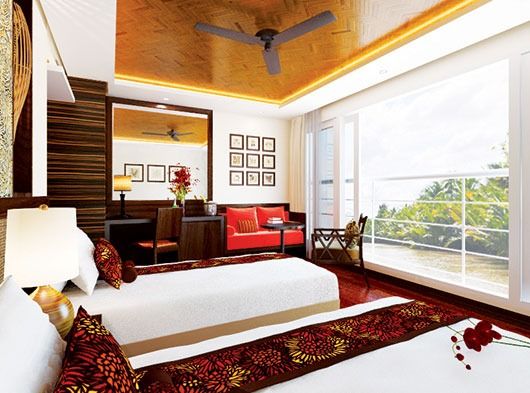
| Grade Code | From | To | |
| A | Panorama Suite (Sapphire Deck Forward) | £7,086 | £7,086 |
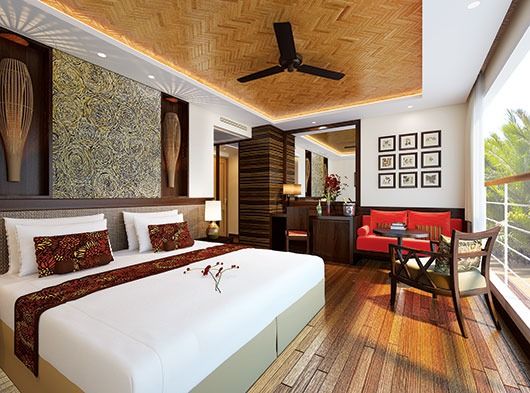
| Grade Code | From | To | |
| B | Panorama Suite (Sapphire Deck Aft) | £6,766 | £6,766 |
The images shown are for illustration purposes only and may not be an exact representation of what you find on the ship.
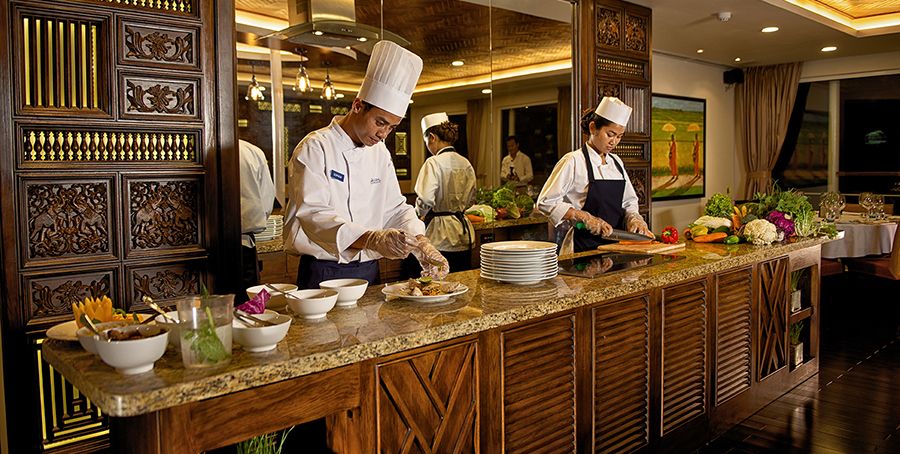
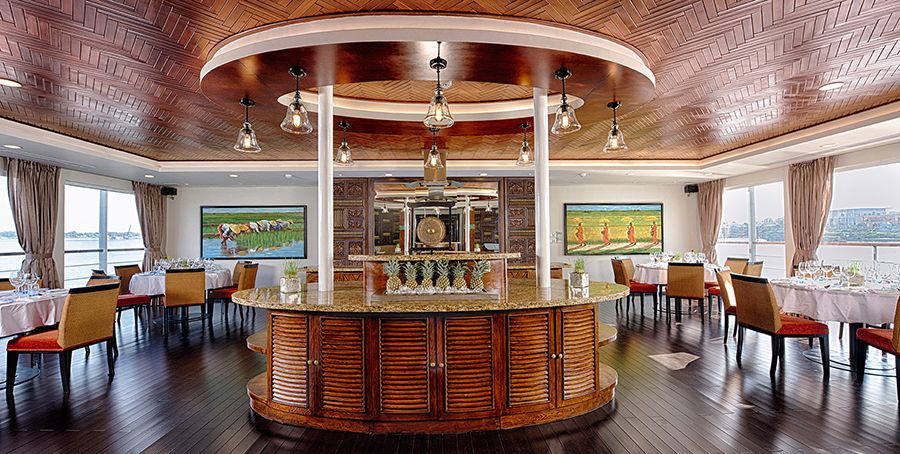
The menu at the Dining Room features a selection of Southeast Asia cuisine and local specialties, based on season and made with fresh local ingredients as well as popular Western dishes. Breakfast and lunch here are buffet-style, the 4-course dinner is served with complimentary wine, beer and soft drinks.
The images shown are for illustration purposes only and may not be an exact representation of what you find on the ship.
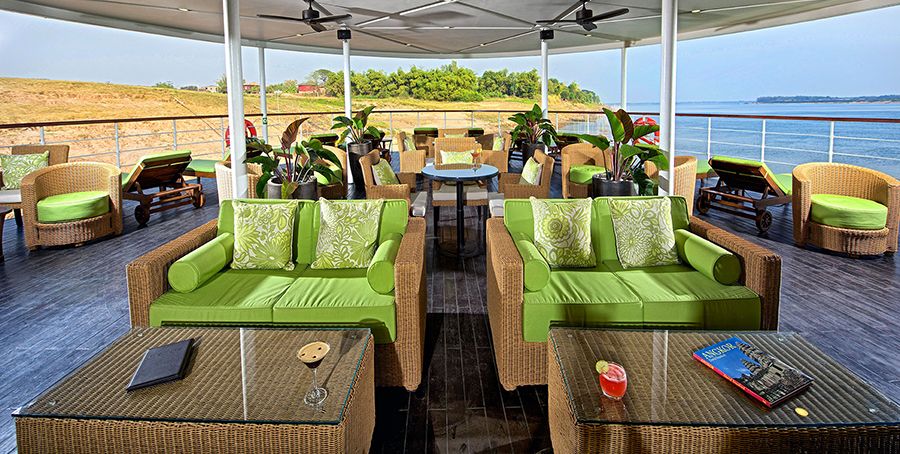
There is an open-air observation lounge with shade system and premium lounge chairs, up on the Top Deck, gives guests a prime view to enjoy with a drink in hand.
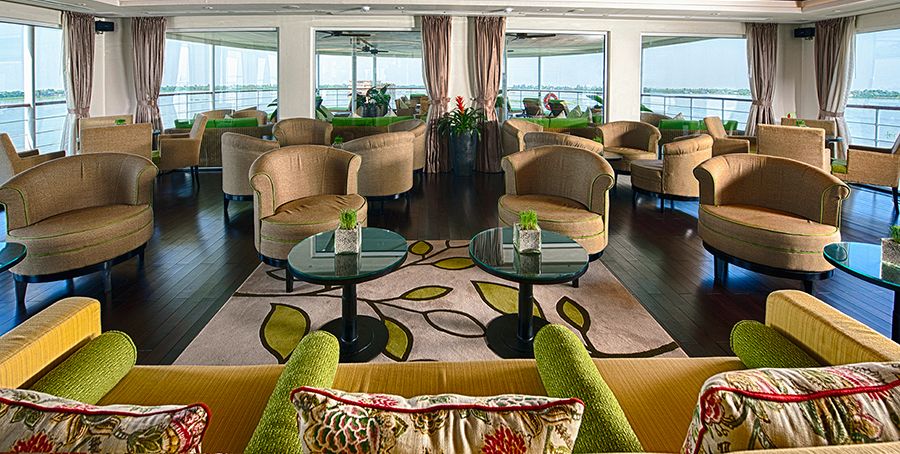
For some casual relaxation and discussion guests can visit the Panorama Lounge, with floor-to-ceiling panoramic windows for a stunning view.
The Panorama Lounge is the Ship's entertainment venue, with stylish furniture, full-service bar and a self-serve beverage station. Here guests can watch a live evening show program by local performers, including dancers and musicians.
Depending on the visited ports along the Avalon Saigon itinerary on Mekong river, the Panorama Lounge also hosts Cambodia and Vietnam culture and history related lectures and multimedia presentations by local speakers. Another entertainment options at the Lounge are the Afternoon Tea service, cocktail hours and movie nights.
The images shown are for illustration purposes only and may not be an exact representation of what you find on the ship.
The images shown are for illustration purposes only and may not be an exact representation of what you find on the ship.
| 3 nights in a hotel before your cruise | |||
| 13 nights cruising on the Mekong | |||
| 1 night in a hotel following your cruise | |||
| Beer, wine & soft drinks at lunch & dinner | |||
| One complimentary shore excursion In every port | |||
| Free Wi-Fi Included | |||
| Exclusive special events | |||
| Speciality wine pairing meal @ Panorama Bistro | |||
| Bikes for passenger use | |||
| Port Taxes and Fees | |||
 | ABTA and ATOL Protection* | ||
Date 2nd Dec 2024 |
Nts 17 |
Please Call for Availability |
Date 2nd Dec 2024 |
Nts 17 |
Please Call for Availability |
| Balcony staterooms |  | ||
| B | Panorama Suite (Sapphire Deck Aft) |  | |
| A | Panorama Suite (Sapphire Deck Forward) |  | |
Fusion Cruises when selling travel arrangements is a trading name of The Midcounties Co-operative Ltd. Fusion Cruises is an Accredited Body Member of Midcounties Co-operative Travel Consortium. (ABTA:P6652, ATOL:6053).
Book with Confidence. We are a Member of ABTA which means you have the benefit of ABTA’s assistance and Code of Conduct.
Some of the flights and flight-inclusive holidays on this website are financially protected by the ATOL scheme but ATOL protection does not apply to all holiday and travel services offered on this website. This website will provide you with information on the protection that applies in the case of each holiday and travel service offered before you make your booking. If you do not receive an ATOL Certificate then the booking will not be ATOL protected. If you do receive an ATOL Certificate but all parts of your trip are not listed on it, those parts will not be ATOL protected. Please see our booking conditions for information, or for more information about financial protection and the ATOL Certificate go to: www.caa.co.uk
